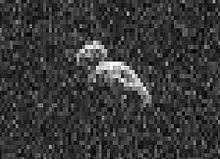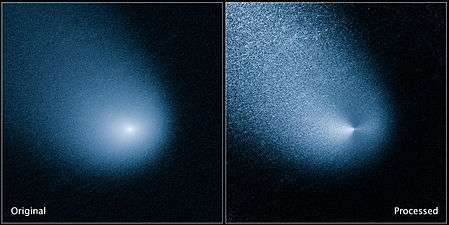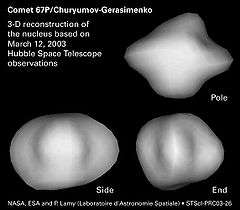2009 RR
| Discovery[1] | |
|---|---|
| Discovered by | Catalina Sky Survey (703) |
| Discovery date | 11 September 2009 |
| Designations | |
| MPC designation | 2009 RR |
| Apollo NEO[2] | |
| Orbital characteristics[2] | |
| Epoch 13 January 2016 (JD 2457400.5) | |
| Uncertainty parameter 7 | |
| Observation arc |
4 days (last seen 2009) |
| Aphelion | 2.0753 AU (310.46 Gm) (Q) |
| Perihelion | 0.75416 AU (112.821 Gm) (q) |
| 1.4147 AU (211.64 Gm) (a) | |
| Eccentricity | 0.46693 (e) |
| 1.68 yr (614.63 d) | |
| 252.65° (M) | |
| 0° 35m 8.592s /day (n) | |
| Inclination | 6.1464° (i) |
| 174.21° (Ω) | |
| 256.21° (ω) | |
| Earth MOID | 0.0028846 AU (431,530 km) |
| Jupiter MOID | 3.25907 AU (487.550 Gm) |
| Physical characteristics | |
| Dimensions |
~26 meters (85 ft)[3] 20–45 meters |
| Mass | 2.4×107 kg (assumed) |
| 25.5[2] | |
|
| |
2009 RR is an Apollo near-Earth asteroid.[2] It was discovered on 11 September 2009 by the Catalina Sky Survey at an apparent magnitude of 19.5 using a 0.68-meter (27 in) Schmidt–Cassegrain telescope.[1] 2009 RR was the only asteroid discovered before 2014 that was predicted to potentially pass inside the orbit of the Moon during 2014. The asteroid has an estimated diameter of 26 meters (85 ft) and is listed on the Sentry Risk Table.[3] It is not large enough to qualify as a potentially hazardous object.
With an observation arc of only 4 days, the asteroid has a poorly determined orbit.[2] It is already known that there is no risk of an Earth impact before 2098.[3] The power of such an air burst would be somewhere between the Chelyabinsk meteor and the Tunguska event depending on the actual size of the asteroid.
The nominal orbit shows that on 16 September 2014 the asteroid could have passed just inside one lunar distance from Earth,[4] but the orbital uncertainties show that it could have passed as much as 0.1 AU (15,000,000 km; 9,300,000 mi) from Earth.[5] On 9 September 2014 the full moon may have only be 15 degrees from the 20th magnitude asteroid, making it difficult to detect the asteroid.[4] The asteroid was estimated to be brighter than magnitude 20 from 10 September until 16 September 2014.[4] 2009 RR was not recovered during the 2014 approach and thus probably passed more than one lunar distance from Earth.
References
- 1 2 "MPEC 2009-R39 : 2009 RR". IAU Minor Planet Center. 2009-09-11. Retrieved 2014-01-13. (K09R00R)
- 1 2 3 4 5 "JPL Small-Body Database Browser: (2009 RR)" (last observation: 2009-09-15; arc: 4 days). Jet Propulsion Laboratory. Retrieved 30 March 2016.
- 1 2 3 "Earth Impact Risk Summary: 2009 RR". NASA/JPL Near-Earth Object Program Office. Retrieved 2014-01-13.
- 1 2 3 "2009RR Ephemerides for September 2014". NEODyS (Near Earth Objects – Dynamic Site). Retrieved 2014-01-15.
- ↑ "JPL Close-Approach Data: (2009 RR)" (last observation: 2009-09-15; arc: 4 days). Retrieved 2014-01-13.
External links
- Orbital simulation from JPL (Java) / Ephemeris
- 2009 RR at the JPL Small-Body Database



